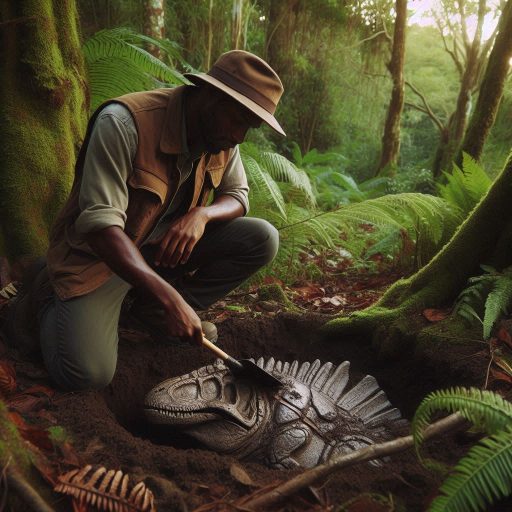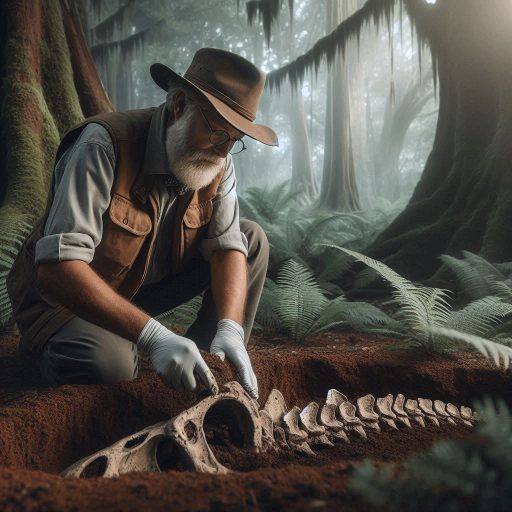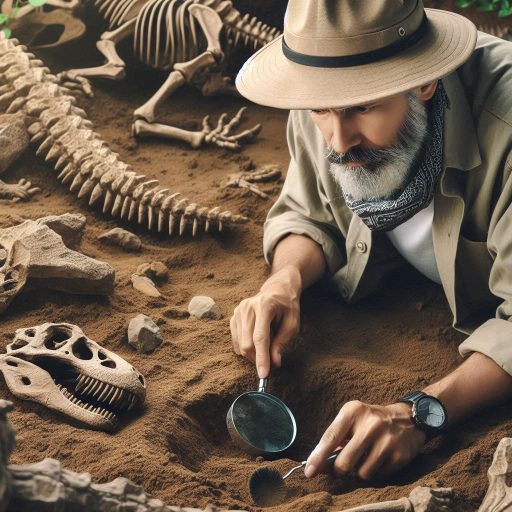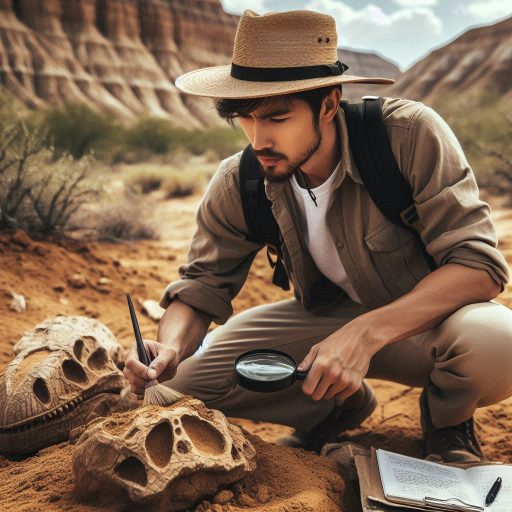Introduction
Paleontology is the scientific study of ancient life through the examination of fossils.
This field provides crucial insights into Earth‘s biological and ecological history.
By analyzing fossils, scientists learn about species’ evolution and interactions over millions of years.
Studying paleontology is important for understanding the development of life on our planet.
It helps us recognize patterns of extinction and adaptation.
These insights inform our knowledge of current biodiversity and environmental changes.
Paleontology also offers context for contemporary issues, such as climate change and conservation.
Within paleontology, several distinct branches exist, each focusing on different aspects of ancient life.
Vertebrate paleontology studies fossils of animals with backbones, including dinosaurs and mammals.
Invertebrate paleontology examines fossils of organisms without backbones, like mollusks and trilobites.
Paleoecology investigates ancient ecosystems and their interactions, providing context for fossil findings.
Other branches, such as ichnology (the study of trace fossils) and paleobotany (the study of ancient plants), further enrich the field.
This blog post will explore these branches, highlighting their unique contributions to understanding Earth‘s history.
By delving into these areas, we appreciate the diversity of life that once thrived on our planet.
Paleobotany
Definition of Paleobotany
Paleobotany is the branch of paleontology that focuses on the study of ancient plant life.
This field examines fossilized plants and their structures.
By analyzing these fossils, paleobotanists learn about prehistoric ecosystems and plant evolution.
They explore how ancient plants interacted with their environments.
Paleobotany plays a crucial role in understanding Earth‘s biological history.
Researchers in paleobotany study various plant groups, including ferns, flowering plants, and gymnosperms.
They analyze plant fossils to gather insights about their characteristics and adaptations.
This study also includes examining plant relationships and diversity throughout geological time.
Paleobotany contributes significantly to our understanding of how plant life has evolved.
Study of Ancient Plant Life
Paleobotanists study fossilized remains of plants, including leaves, seeds, and wood.
These fossils provide critical information about past vegetation.
By examining these remains, scientists can reconstruct ancient landscapes and ecosystems.
They also assess how plant life responded to changing climates.
Ancient plant life offers insights into the history of life on Earth.
For example, the presence of certain plants can indicate specific climatic conditions.
This information helps scientists understand how ecosystems evolved and adapted over time.
Paleobotanists often work with fossils found in sedimentary rocks, which preserve plant remains well.
They analyze these fossils to identify species and determine their age.
This process often involves comparing fossils with modern relatives to establish relationships and similarities.
Methods Used in Paleobotany
Paleobotanists use various methods to study ancient plants.
They often employ techniques such as stratigraphy and palynology.
Stratigraphy involves analyzing rock layers to determine the age of fossils.
This technique helps scientists place plant fossils in a chronological context.
Palynology, the study of pollen and spores, is another important method.
Pollen grains are often well-preserved in sediments, providing valuable information about past plant communities.
Analyzing pollen samples helps scientists reconstruct ancient climates and ecosystems.
Additionally, modern imaging techniques assist paleobotanists in examining fossils in detail.
Methods such as X-ray computed tomography (CT) allow for non-destructive analysis of plant structures.
These techniques reveal internal features and help identify species accurately.
Significance of Paleobotany in Understanding Past Climates
Paleobotany plays a significant role in understanding past climates and environmental changes.
Ancient plant life reflects the climatic conditions of its time.
By studying fossilized plants, scientists can infer temperature, precipitation, and atmospheric composition from previous eras.
This knowledge helps researchers understand how ecosystems responded to climate shifts.
For example, changes in plant species can indicate warming or cooling trends.
Paleobotany provides critical data for modeling future climate scenarios and their potential impacts on ecosystems.
Moreover, studying ancient plant life can inform conservation efforts.
Understanding how plants adapted to past climate changes can guide current and future conservation strategies.
Paleobotanists contribute valuable insights into biodiversity and ecosystem resilience, highlighting the importance of preserving plant species today.
In review, paleobotany is a vital branch of paleontology that enhances our understanding of ancient plant life.
By employing various methods, paleobotanists uncover crucial information about past climates and ecosystems.
Their work ultimately enriches our knowledge of Earth‘s biological history and the ongoing challenges of climate change.
Read: Essential Skills and Tools for Modern Chemists in America
Micropaleontology
Exploring Micropaleontology: A Deep Dive into the Small
Micropaleontology is a specialized branch of paleontology that studies microscopic fossils.
This field focuses on organisms that are often invisible to the naked eye.
Despite their small size, these microfossils provide significant insights into Earth’s history.
Let’s explore the importance and applications of micropaleontology.
Understanding Microfossils
Microfossils are fossilized remains of tiny organisms.
These can include foraminifera, diatoms, and pollen grains.
Each microfossil type offers unique information about past environments.
Their small size allows for sampling from various geological formations.
Scientists often find microfossils in sedimentary rocks, clay, and marine deposits.
Analyzing these fossils requires specialized techniques and tools.
Micropaleontologists utilize microscopes to examine and identify these tiny specimens.
Their work helps reconstruct ancient ecosystems and understand evolutionary processes.
Contributions to Biostratigraphy and Paleoecology
Micropaleontology plays a crucial role in biostratigraphy, the study of rock layers and their fossil content.
Microfossils serve as key indicators for dating geological formations.
They help scientists establish relative ages based on fossil assemblages.
This information is vital for understanding Earth’s geological history and the timing of events.
Moreover, micropaleontology aids in paleoecology, which examines ancient ecosystems.
Microfossils provide insights into past environmental conditions.
They reveal information about climate changes, sea level fluctuations, and sedimentation rates.
By studying these organisms, scientists can infer how ecosystems responded to various factors over time.
Microfossils also help identify specific environments where they formed.
For example, certain foraminifera thrive in shallow marine settings, while others inhabit deeper waters.
Analyzing these distributions allows researchers to reconstruct ancient habitats and their evolution.
Applications of Micropaleontology in Oil Exploration
Micropaleontology has important applications in the oil and gas industry.
Oil companies often rely on micropaleontological studies for exploration and production.
Microfossils provide valuable data about sedimentary environments, which is critical for locating oil reservoirs.
In petroleum geology, micropaleontologists analyze samples from drilling operations.
They identify microfossils to determine the age and depositional environment of rock formations.
This information helps geologists map potential oil reserves.
By understanding the geological history, companies can make informed drilling decisions.
Microfossils assist in identifying reservoir quality.
They provide clues about porosity and permeability within rock layers.
Understanding these characteristics is essential for effective oil extraction.
Moreover, micropaleontologists can assess the impact of drilling on local ecosystems.
By monitoring microfossil populations, researchers can evaluate environmental changes caused by oil extraction.
Micropaleontology is a vital branch of paleontology focused on microfossils.
These tiny organisms offer significant insights into biostratigraphy and paleoecology.
Their study helps reconstruct ancient environments and evolutionary processes.
Furthermore, micropaleontology has practical applications in oil exploration, guiding resource identification and extraction.
By exploring this field, scientists uncover crucial information about Earth‘s history and its resources.
Read: The Role of Chemists in US Environmental and Sustainability Efforts
Vertebrate Paleontology
What Vertebrate Paleontology Involves
Vertebrate paleontology is a fascinating branch of paleontology.
It focuses on the study of fossilized animals with backbones.
This field examines a wide range of species, including fish, amphibians, reptiles, birds, and mammals.
Researchers in this discipline analyze skeletal remains to understand ancient life forms.
Vertebrate paleontologists employ various techniques to uncover fossils.
They conduct fieldwork, excavating sites known for rich fossil deposits.
Once fossils are collected, scientists clean, prepare, and analyze them using advanced imaging techniques.
These techniques reveal crucial information about the morphology and biology of ancient vertebrates.
Additionally, vertebrate paleontologists often collaborate with geologists and other specialists.
This interdisciplinary approach enhances their understanding of the environmental context in which these creatures lived.
By studying sediment layers and associated fossils, they can reconstruct ancient ecosystems.
Study of Fossilized Animals with Backbones
The study of fossilized animals with backbones is essential for understanding vertebrate evolution.
Fossils provide evidence of how species adapted to changing environments over millions of years.
Vertebrate paleontology encompasses both extinct and extant (currently living) species, offering a comprehensive view of animal history.
Fossils reveal significant information about the anatomy of ancient vertebrates.
Scientists analyze bone structures, growth patterns, and dental characteristics.
These features help researchers identify relationships between species and track evolutionary changes.
Vertebrate paleontology also includes studying trace fossils, such as footprints or burrows.
These trace fossils provide insight into behavior, locomotion, and social interactions of ancient vertebrates.
By examining these remains, scientists can reconstruct the lifestyles of long-extinct animals.
Famous Discoveries in Vertebrate Paleontology
Several famous discoveries have shaped the field of vertebrate paleontology.
The discovery of Tyrannosaurus rex remains one of the most iconic.
This giant predator provided valuable insights into dinosaur anatomy and behavior.
The fossils have helped scientists understand the evolution of theropod dinosaurs.
Another significant find is Archaeopteryx, often regarded as the first bird.
This fossil bridges the gap between dinosaurs and modern birds.
Its unique features demonstrate the evolutionary transition from dinosaurs to avians.
The discovery of ancient marine reptiles, such as Ichthyosaurs and Plesiosaurs, has also contributed significantly to vertebrate paleontology.
These fossils reveal adaptations to life in the ocean.
They illustrate how vertebrates diversified and thrived in various environments throughout Earth’s history.
Contributions to Understanding Evolution
Vertebrate paleontology contributes immensely to our understanding of evolution.
By studying fossilized remains, scientists can trace evolutionary lineages.
They can identify common ancestors and observe how traits evolved over time.
The field helps explain the process of natural selection.
Fossils document changes in species due to environmental pressures.
Researchers can see how certain adaptations led to survival and reproductive success.
Vertebrate paleontology also provides context for the evolution of biodiversity.
It reveals patterns of extinction and radiation, highlighting how life on Earth has changed.
By piecing together these narratives, vertebrate paleontologists offer critical insights into the history of life.
In summary, vertebrate paleontology involves studying fossilized animals with backbones, making essential contributions to our understanding of evolution.
Famous discoveries continue to shed light on the diverse and complex history of vertebrates.
Read: Day in the Life: An Environmental Scientist‘s Typical Day

Invertebrate Paleontology
Definition of Invertebrate Paleontology
Invertebrate paleontology is the study of fossilized animals that lack backbones.
This branch of paleontology focuses on a diverse group of organisms.
Invertebrates include species such as mollusks, arthropods, and echinoderms.
Researchers in this field examine fossils to understand ancient life forms and their environments.
Invertebrate paleontology plays a critical role in reconstructing past ecosystems.
By studying these organisms, scientists can uncover vital information about ancient marine and terrestrial habitats.
The findings contribute to our knowledge of evolutionary processes and ecological interactions.
Study of Fossilized Animals Without Backbones
The study of invertebrate fossils provides insights into the evolution of life on Earth.
Invertebrates represent about 95% of all animal species.
Their fossilized remains offer a wealth of information about biodiversity throughout history.
Paleontologists analyze the morphology and distribution of invertebrate fossils to identify species and their evolutionary relationships.
Fossilized invertebrates can include shells, exoskeletons, and soft-bodied organisms.
These remnants are essential for understanding the conditions in which they lived.
Researchers often find invertebrate fossils in sedimentary rock layers, which preserve their features well.
Invertebrate fossils also reveal information about ancient climates and environmental changes.
The presence of specific species in particular locations indicates past ecological conditions.
By studying these patterns, scientists can infer how ecosystems responded to global events over time.
Importance of Invertebrate Paleontology in Understanding Ancient Ecosystems
Invertebrate paleontology is crucial for understanding ancient ecosystems.
These organisms were foundational to many ecological communities.
They served as food sources for larger vertebrates and played significant roles in nutrient cycling.
Studying invertebrate fossils helps scientists reconstruct food webs and ecological interactions.
Researchers analyze the relationships between different species and their environments.
This analysis aids in understanding how ecosystems functioned millions of years ago.
Additionally, invertebrate fossils provide insights into mass extinction events.
Many invertebrate species went extinct during significant geological shifts.
By examining the fossil record, paleontologists can identify patterns and causes of these extinctions.
Understanding these events helps scientists predict future biodiversity loss in the face of climate change.
Examples of Well-Known Invertebrate Fossils
Several well-known invertebrate fossils illustrate the importance of this branch of paleontology.
Trilobites are among the most famous invertebrate fossils, with a rich fossil record spanning millions of years.
These extinct marine arthropods provide valuable insights into the Cambrian period.
Another significant group includes ammonites, which are ancient mollusks with distinctive spiral shells.
Their diverse forms and widespread distribution make them excellent index fossils.
Paleontologists often use them to date rock layers accurately.
Brachiopods are also important invertebrate fossils.
These marine organisms resemble clams and were abundant during the Paleozoic era.
Their fossilized remains offer clues about ancient marine environments and biodiversity.
Invertebrate paleontology is vital for understanding ancient ecosystems and evolutionary history.
By studying fossilized animals without backbones, scientists gain valuable insights into life on Earth.
Notable invertebrate fossils, such as trilobites and ammonites, enrich our knowledge of the past.
Transform Your Career Today
Unlock a personalized career strategy that drives real results. Get tailored advice and a roadmap designed just for you.
Start NowRead: The Impact of Technology on the Chemist Profession in the US
Paleoecology
Definition of Paleoecology
Paleoecology is the study of ancient ecosystems and their interactions.
It examines how organisms lived and interacted with their environments in the past.
By analyzing fossil records, paleoecologists reconstruct ancient habitats.
They study the relationships among species and their surroundings.
Paleoecology incorporates various scientific disciplines, including geology, biology, and climate science.
This multidisciplinary approach provides a comprehensive understanding of past life on Earth.
Study of Ancient Ecosystems
Paleoecologists focus on different types of ancient ecosystems, such as forests, wetlands, and marine environments.
They analyze fossilized plants and animals to understand ecosystem dynamics.
The presence of specific species indicates the characteristics of the environment.
For instance, the discovery of ferns suggests a humid climate.
Similarly, the presence of coral fossils indicates a marine ecosystem.
By studying these indicators, paleoecologists can infer climatic conditions and habitat types.
Fossil pollen is another valuable tool in paleoecology.
It helps reconstruct past vegetation and climatic conditions.
By identifying pollen types, researchers can determine which plants thrived in certain periods.
This information aids in understanding shifts in ancient environments over time.
How Paleoecology Helps in Understanding Ancient Environments
Paleoecology offers insights into how ancient organisms adapted to their environments.
It helps scientists understand evolutionary processes and species interactions.
By examining food webs, researchers can infer how energy flowed through ecosystems.
Paleoecologists also study mass extinction events to understand their causes and effects.
Analyzing the fossil record during these times provides valuable information about ecological recovery.
Understanding how ecosystems rebounded helps scientists predict future ecological responses to change.
Moreover, paleoecology sheds light on the long-term impacts of climate change.
By examining ancient environments, researchers can identify patterns of change over geological time.
This knowledge helps contextualize current climate challenges and their potential consequences.
Importance of Paleoecology in Conservation Efforts
Paleoecology plays a crucial role in conservation biology.
It provides a historical baseline for understanding current ecosystems.
By comparing modern environments with ancient data, researchers identify changes and threats to biodiversity.
Conservationists can use paleoecological data to inform management practices.
Understanding how ecosystems functioned in the past guides efforts to restore habitats.
This approach helps ensure that conservation efforts are effective and sustainable.
Paleoecology aids in predicting future ecological outcomes.
By analyzing how ecosystems responded to past climate changes, scientists can anticipate future challenges.
This knowledge is vital for developing adaptive strategies for conservation.
In essence, paleoecology is essential for understanding ancient ecosystems and their dynamics.
It informs current conservation efforts by providing a historical perspective.
As scientists continue to study ancient environments, they gain valuable insights for protecting our planet‘s biodiversity.
Ultimately, paleoecology bridges the past and present, helping us navigate the future of Earth‘s ecosystems.
You Might Also Like: Funding Opportunities for Marine Biology Research
Taphonomy
Explanation of Taphonomy
Taphonomy is a crucial branch of paleontology that studies the processes affecting organisms after death.
The term originates from the Greek words ‘taphos,‘ meaning burial, and ‘nomos,‘ meaning law.
Taphonomy encompasses all events that occur between an organism’s death and its fossilization.
These processes include decay, transport, and burial.
Understanding taphonomy is essential for interpreting fossil records accurately.
Study of Processes Affecting Organisms After Death
Taphonomy examines how various factors influence the preservation of organic remains.
Environmental conditions play a significant role in this process.
For example, temperature, humidity, and oxygen levels can affect decay rates.
Organisms in dry, low-oxygen environments often preserve better than those in humid, oxygen-rich settings.
Scavengers and decomposers also impact the preservation of remains.
Animals that feed on carcasses can disrupt the fossilization process.
Similarly, microorganisms break down organic materials, influencing what remains for future study.
By understanding these interactions, researchers can reconstruct ancient environments more accurately.
Role of Taphonomy in Studying Fossilization
Taphonomy is vital for understanding the fossilization process itself.
Fossilization occurs under specific conditions, often influenced by taphonomic factors.
For instance, rapid burial increases the likelihood of fossilization.
Taphonomic studies help paleontologists identify why some organisms fossilize while others do not.
Through taphonomic analysis, scientists can learn about the conditions that led to fossil preservation.
They examine how sediment type, burial depth, and mineral content affect fossilization.
This knowledge helps reconstruct past ecosystems and climatic conditions.
Understanding these factors provides context for interpreting fossil assemblages.
Moreover, taphonomy assists in determining the age of fossils.
By analyzing the surrounding sediment and geological context, researchers can estimate the time frame of deposition.
This information is crucial for establishing timelines in the history of life on Earth.
Applications of Taphonomy in Forensic Science
Taphonomy extends beyond paleontology; it also plays a vital role in forensic science.
Forensic taphonomy applies principles of taphonomy to modern-day investigations.
It helps forensic scientists understand the post-mortem changes that occur in human remains.
For example, forensic taphonomists study how environmental factors affect the decomposition of bodies.
They examine how temperature, humidity, and other conditions influence decay rates.
This information aids in estimating the time of death in criminal investigations.
Forensic taphonomy can help identify the circumstances surrounding a person’s death.
By analyzing the condition of remains, forensic scientists can infer whether the body was moved or buried.
This knowledge is invaluable for solving crimes and understanding death-related scenarios.
Taphonomy is a vital branch of paleontology that examines post-mortem processes affecting organisms.
It plays a significant role in studying fossilization, helping researchers reconstruct ancient environments.
Moreover, its applications extend to forensic science, where it aids in criminal investigations.
By understanding taphonomy, scientists can uncover the secrets of both ancient and modern life, bridging the gap between the past and present.
Ichnology
Definition of Ichnology
Ichnology is the branch of paleontology that focuses on trace fossils.
Trace fossils differ from body fossils, which represent actual organisms.
Instead, trace fossils provide evidence of an organism’s behavior and activity.
They include footprints, burrows, and feeding marks left in sediment.
Ichnologists study these marks to gain insights into ancient life.
Study of Trace Fossils
The study of trace fossils reveals much about past ecosystems.
Ichnologists examine the shape, size, and arrangement of these fossils.
This information helps them interpret the behavior of ancient organisms.
For instance, they can analyze a set of dinosaur footprints to infer movement patterns.
Trace fossils also indicate the environment in which an organism lived.
The presence of specific trace fossils can suggest habitat conditions.
Ichnologists often work with sedimentologists to reconstruct ancient environments.
They correlate trace fossil data with geological context for better understanding.
Importance of Ichnology in Understanding Behavior of Ancient Organisms
Ichnology plays a crucial role in understanding the behavior of ancient organisms.
By studying trace fossils, ichnologists can uncover feeding habits, locomotion, and social interactions.
For example, groups of footprints can suggest social behavior in dinosaurs.
Trace fossils also provide insights into developmental stages.
For instance, they can indicate how young animals moved compared to adults.
Ichnology allows researchers to explore evolutionary trends over time.
By analyzing changes in trace fossils, they can track adaptations in different species.
Moreover, ichnology contributes to our understanding of ecological dynamics.
It reveals interactions between species and their environments.
By examining trace fossils, scientists can infer predator-prey relationships.
This information enriches our knowledge of ancient food webs.
Examples of Trace Fossils and Their Significance
Many trace fossils serve as significant indicators of ancient life.
Footprints, or ichnites, provide valuable information about movement and behavior.
For example, dinosaur tracks reveal insights into their size, gait, and social interactions.
Analyzing these tracks can help reconstruct migration patterns.
Burrows are another important category of trace fossils.
They indicate where organisms lived and how they interacted with their environments.
For instance, burrows left by ancient mammals can reveal information about their behavior and lifestyle.
Feeding traces, such as bite marks on plants or shells, help researchers understand diets.
These traces provide direct evidence of what ancient organisms consumed.
Analyzing feeding traces also sheds light on competition among species.
Additionally, coprolites, or fossilized feces, offer direct evidence of ancient diets.
They provide insights into what animals ate and their ecological roles.
Studying coprolites helps ichnologists understand food webs in ancient ecosystems.
Ichnology is a vital branch of paleontology that focuses on trace fossils.
By studying these fossils, scientists gain valuable insights into the behavior of ancient organisms.
Examples like footprints, burrows, and coprolites enhance our understanding of past ecosystems.
The significance of ichnology continues to grow, offering essential clues about life on Earth‘s ancient landscapes.
Discover More: Volunteer Opportunities in Marine Biology
Conclusion
Paleontology encompasses various branches, each focusing on unique aspects of ancient life.
Vertebrate paleontology studies fossilized remains of animals with backbones, including dinosaurs and mammals.
Invertebrate paleontology examines fossils of animals without backbones, such as mollusks and arthropods.
Paleoecology explores ancient ecosystems, providing insights into how different species interacted within their environments.
Micropaleontology focuses on microscopic fossils, helping scientists understand past climates and oceanic conditions.
Ichnology investigates fossilized tracks and traces, revealing behaviors of ancient organisms.
Each branch contributes to our understanding of Earth‘s history.
By studying different aspects of life through time, paleontologists piece together complex narratives of evolution and extinction.
This research helps us appreciate the biodiversity that once existed on our planet.
Readers interested in these branches should delve deeper into paleontology’s diverse field.
Explore specialized literature, attend lectures, or participate in workshops to broaden your knowledge.
Engaging with this fascinating discipline can lead to new discoveries and inspire future research.
Continuing research in paleontology is vital for uncovering Earth’s history.
Every fossil found adds to the story of life on our planet.
By supporting paleontological studies, we can better understand our past and its implications for the future.




